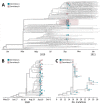Interventions to Disrupt Coronavirus Disease Transmission at a University, Wisconsin, USA, August-October 2020
- PMID: 34586058
- PMCID: PMC8544969
- DOI: 10.3201/eid2711.211306
Interventions to Disrupt Coronavirus Disease Transmission at a University, Wisconsin, USA, August-October 2020
Abstract
University settings have demonstrated potential for coronavirus disease (COVID-19) outbreaks; they combine congregate living, substantial social activity, and a young population predisposed to mild illness. Using genomic and epidemiologic data, we describe a COVID-19 outbreak at the University of Wisconsin-Madison, Madison, Wisconsin, USA. During August-October 2020, a total of 3,485 students, including 856/6,162 students living in dormitories, tested positive. Case counts began rising during move-in week, August 25-31, 2020, then rose rapidly during September 1-11, 2020. The university initiated multiple prevention efforts, including quarantining 2 dormitories; a subsequent decline in cases was observed. Genomic surveillance of cases from Dane County, in which the university is located, did not find evidence of transmission from a large cluster of cases in the 2 quarantined dorms during the outbreak. Coordinated implementation of prevention measures can reduce COVID-19 spread in university settings and may limit spillover to the surrounding community.
Keywords: COVID-19; COVID-19 testing; SARS-CoV-2; United States; University of Wisconsin–Madison; Wisconsin; coronavirus disease; dormitory; respiratory infections; severe acute respiratory syndrome coronavirus 2; students; university; viruses; whole-genome sequencing; zoonoses.
Figures




References
-
- Cai W, Ivory D, Semple K, Smith M, Lemonides A, Higgins L, et al. Tracking coronavirus cases at U.S. colleges and universities. The New York Times. 2021. [cited 2021 Mar 1]. https://www.nytimes.com/interactive/2021/us/college-covid-tracker.html
-
- Centers for Disease Control and Prevention. COVID-19 parental resources kit—young adulthood. Updated December 28, 2020. [cited 2021 Apr 15]. https://www.cdc.gov/coronavirus/2019-ncov/daily-life-coping/parental-res...
Publication types
MeSH terms
Grants and funding
LinkOut - more resources
Full Text Sources
Medical
Miscellaneous

